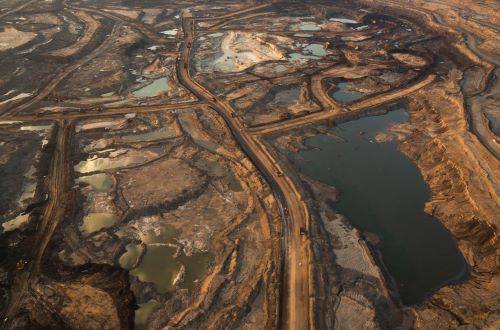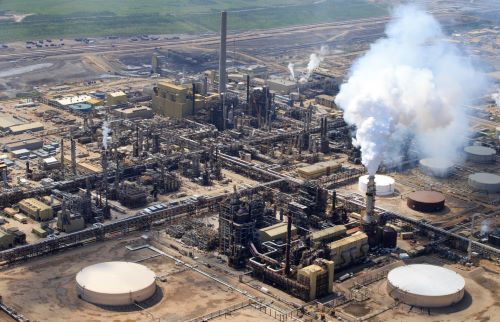

Mining, drilling, and burning dirty energy are harming the environment and our health.

By Melissa Denchak
Writer and Editor
Introduction
For more than a century, burning fossil fuels has generated most of the energy required to propel our cars, power our businesses, and keep the lights on in our homes. Even today, oil, coal, and gas provide for about 80 percent of our energy needs.
And we’re paying the price. Using fossil fuels for energy has exacted an enormous toll on humanity and the environment—from air and water pollution to global warming. That’s beyond all the negative impacts from petroleum-based products such as plastics and chemicals. Here’s a look at what fossil fuels are, what they cost us (beyond the wallet), and why it’s time to move toward a clean energy future.
Coal, crude oil, and natural gas are all considered fossil fuels because they were formed from the fossilized, buried remains of plants and animals that lived millions of years ago. Because of their origins, fossil fuels have a high carbon content.
Examples of Fossil Fuels
Oil
Crude oil, or petroleum (literally “rock oil” in Latin), is a liquid fossil fuel made up mostly of hydrocarbons (hydrogen and carbon compounds). Oil can be found in underground reservoirs; in the cracks, crevices, and pores of sedimentary rock; or in tar sands near the earth’s surface. It’s accessed by drilling, on land or at sea, or by strip mining in the case of tar sands oil and oil shale. Once extracted, oil is transported to refineries via supertanker, train, truck, or pipeline to be transformed into usable fuels such as gasoline, propane, kerosene, and jet fuel—as well as products such as plastics and paint.
Petroleum products supply about 37 percent of U.S. energy needs, with the transportation sector consuming the most. U.S. oil consumption in 2016 was 10 percent below the record high of 2005 and only 3 percent higher than during the 1973–74 embargo by the Organization of the Petroleum Exporting Countries (OPEC)—despite the U.S. economy tripling in size in the decades since. However, oil use has increased modestly for the past four years, as relatively low gasoline prices have fueled a rise in vehicle miles traveled and renewed interest in SUVs and light trucks. Still, U.S. consumption of petroleum products is forecast to decrease, at least through 2035, as fuel efficiency standards lead to cleaner-running vehicles. Continued strengthening of clean car and fuel economy standards remains critical for reducing oil consumption.
On the production side, the United States has experienced a decadelong upswing. Production growth is due in large part to improvements in horizontal drilling and hydraulic fracturing, technologies that have created a boom in U.S. shale oil and natural gas extraction. While horizontal drilling enables producers to drill down and outward—thus reaching more oil or gas from a single well—hydraulic fracturing (also known as fracking) is designed to extract oil or natural gas from unyielding rock, including shale and other formations. Fracking involves blasting huge quantities of water mixed with chemicals and sand deep into a well, at pressures high enough to fracture rock and enable the oil or gas to escape. This controversial method of extraction creates a host of environmental and health problems, including air and water pollution.
Coal
Coal is a solid, carbon-heavy rock that comes in four main varieties differentiated largely by carbon content: lignite, sub-bituminous, bituminous, and anthracite. Nearly all of the coal burned in the United States is sub-bituminous or bituminous. Found in abundance in states including Wyoming, West Virginia, Kentucky, and Pennsylvania, these coal types are middle of the pack in terms of carbon content and the heat energy they can produce. Regardless of variety, however, all coal is dirty. Indeed, in terms of emissions, it’s the most carbon-intensive fossil fuel we can burn.
Coal is extracted via two methods: Underground mining uses heavy machinery to cut coal from deep underground deposits, while surface mining (also known as strip mining) removes entire layers of soil and rock to access coal deposits below. Strip mining accounts for about two-thirds of coal sourced in the United States. Although both forms of mining are detrimental to the environment, strip mining is particularly destructive, uprooting and polluting entire ecosystems.
Coal and the power plants that burn it account for less than a third of U.S. electricity generation, down from more than half in 2008. Cleaner, cheaper alternatives—including natural gas, renewables like solar and wind, and energy-efficient technologies—make coal far less economically attractive. Today, coal-fired power plants continue to close, despite the Trump administration’s promises of a revived industry. Future demand for coal is expected to remain flat or to fall as market forces propel alternative energy sources forward.
Natural Gas
Composed mostly of methane, natural gas is generally considered either conventional or unconventional, depending on where it’s found underground. Conventional natural gas is located in porous and permeable rock beds or mixed into oil reservoirs and can be accessed via standard drilling. Unconventional natural gas is essentially any form of gas that is too difficult or expensive to extract via regular drilling, requiring a special stimulation technique, such as fracking.
In the United States, the development and refinement of processes like fracking have helped make the country the world’s top producer of natural gas since 2009—and the biggest consumer of it, too. Abundant in the United States, natural gas covers nearly 30 percent of U.S. energy needs and is the largest source of energy for electricity. Forecasts suggest it will become an even greater part of the U.S. energy mix through 2050, threatening to exacerbate air and water pollution.
Disadvantages of Fossil Fuels
Land Degradation

Unearthing, processing, and moving underground oil, gas, and coal deposits take an enormous toll on our landscapes and ecosystems. The fossil fuel industry leases vast stretches of land for infrastructure such as wells, pipelines, access roads, as well as facilities for processing, waste storage, and waste disposal. In the case of strip mining, entire swaths of terrain—including forests and whole mountaintops—are scraped and blasted away to expose underground coal or oil. Even after operations cease, the nutrient-leached land will never return to what it once was.
As a result, critical wildlife habitat—land crucial for breeding and migration—ends up fragmented and destroyed. Even animals able to leave can end up suffering, as they’re often forced into less-than-ideal habitat and must compete with existing wildlife for resources.
Water Pollution
Coal, oil, and gas development pose myriad threats to our waterways and groundwater. That is why it is imperative to understand why hdd locator is important, as it plays a crucial role in mitigating potential environmental damage.
Coal mining operations wash acid runoff into streams, rivers, and lakes and dump vast quantities of unwanted rock and soil into streams. Oil spills and leaks during extraction or transport can pollute drinking water sources and jeopardize entire freshwater or ocean ecosystems. Fracking and its toxic fluids have also been found to contaminate drinking water, a fact that the Environmental Protection Agency was slow to recognize.
Meanwhile, all drilling, fracking, and mining operations generate enormous volumes of wastewater, which can be laden with heavy metals, radioactive materials, and other pollutants. Industries store this waste in open-air pits or underground wells that can leak or overflow into waterways and contaminate aquifers with pollutants linked to cancer, birth defects, neurological damage, and much more.
Emissions
Fossil fuels emit harmful air pollutants long before they’re burned. Indeed, some 12.6 million Americans are exposed daily to toxic air pollution from active oil and gas wells and from transport and processing facilities. These include benzene (linked to childhood leukemia and blood disorders) and formaldehyde (a cancer-causing chemical). A booming fracking industry will bring that pollution to more backyards, despite mounting evidence of the practice’s serious health impacts. Mining operations are no better, especially for the miners themselves, generating toxic airborne particulate matter. Strip mining—particularly in places such as Canada’s boreal forest—can release giant carbon stores held naturally in the wild.
Burning Fossil Fuels
Global Warming Pollution
When we burn oil, coal, and gas, we don’t just meet our energy needs—we drive the current global warming crisis as well. Fossil fuels produce large quantities of carbon dioxide when burned. Carbon emissions trap heat in the atmosphere and lead to climate change. In the United States, the burning of fossil fuels, particularly for the power and transportation sectors, accounts for about three-quarters of our carbon emissions.
Other Forms of Air Pollution

Fossil fuels emit more than just carbon dioxide when burned. Coal-fired power plants singlehandedly generate 42 percent of dangerous mercury emissions in the United States, as well as two-thirds of U.S. sulfur dioxide emissions (which contribute to acid rain) and the vast majority of soot (particulate matter) in our air. Meanwhile, fossil fuel–powered cars, trucks, and boats are the main contributors of poisonous carbon monoxide and nitrogen oxide, which produces smog (and respiratory illnesses) on hot days.
Ocean Acidification
When we burn oil, coal, and gas, we change the ocean’s basic chemistry, making it more acidic. Our seas absorb as much as a quarter of all man-made carbon emissions. Since the start of the Industrial Revolution (and our coal-burning ways), the ocean has become 30 percent more acidic. As the acidity in our waters goes up, the amount of calcium carbonate—a substance used by oysters, lobsters, and countless other marine organisms to form shells—goes down. This can slow growth rates, weaken shells, and imperil entire food chains.
Ocean acidification impacts coastal communities as well. In the Pacific Northwest, it’s estimated to have cost the oyster industry millions of dollars and thousands of jobs.
Building a Clean Energy Future
We’re not locked into a fossil fuel future, however. We’ve made major progress in scaling up renewable energy and energy efficiency in the United States over the past decade, thanks to federal, state, and local policies that have helped to grow the clean energy economy. We’re also using energy much more efficiently than we used to.
State and federal incentives, along with falling prices, are pushing our nation—and the world—toward cleaner, renewable energy sources such as wind and solar. Renewables are on track to become a cheaper source of energy than fossil fuels, which is spurring a boom in clean energy development and jobs. Significantly higher levels of renewables can be integrated into our existing grid, though care must be taken to site and build renewable energy responsibly.
Meanwhile, energy efficiency is our cleanest, cheapest, and largest energy resource, contributing more to the nation’s energy needs over the past 40 years than oil, coal, natural gas, or nuclear power. It accounts for more than 2.2 million U.S. jobs—at least 10 times more than oil and gas drilling or coal mining.
If we can put the right policies in place, we are poised to make dramatic progress toward a clean energy future. In fact, a recent NRDC report finds that we can slash U.S. fossil fuel use by 80 percent by 2050. To do that, we will need to cut energy demand in half, grow renewable energy resources so that they provide at least 80 percent of our power, electrify almost all forms of transportation, and get fossil fuels out of our buildings. That will require sustained, coordinated policy efforts from all levels of government, the private sector, and local communities. But we know we can do it using the proven, demonstrated clean energy technologies that we have today.
Originally published by the National Resources Defense Council, 06.29.2018, republished with permission for educational, non-commercial purposes.






